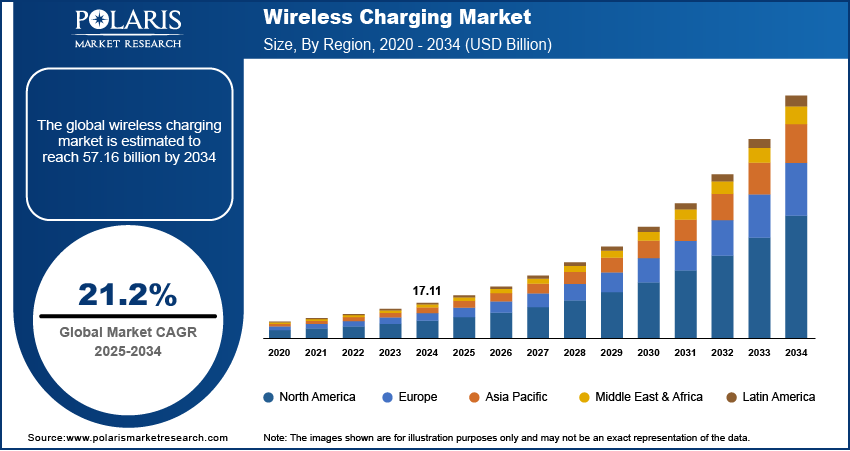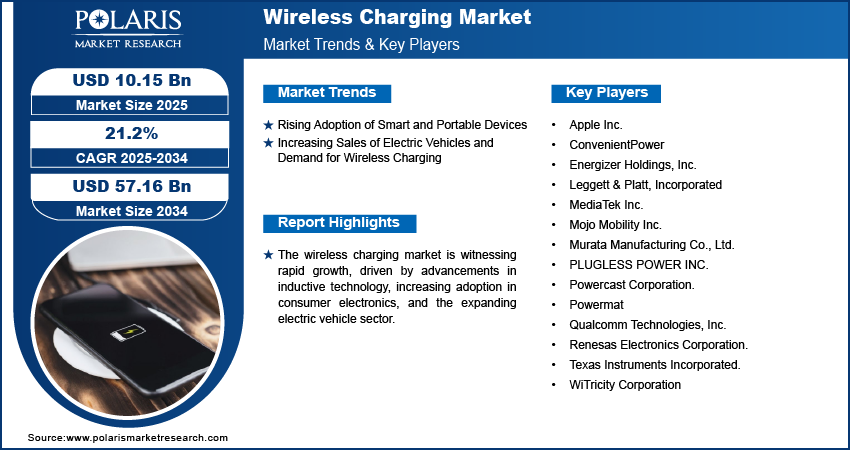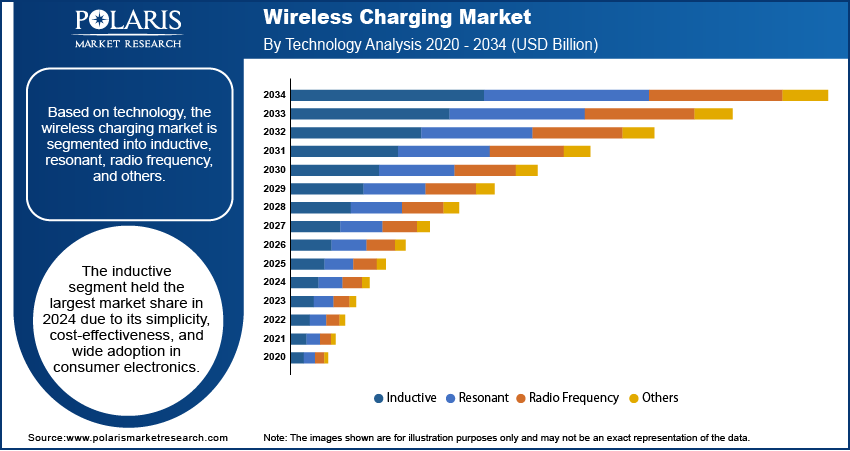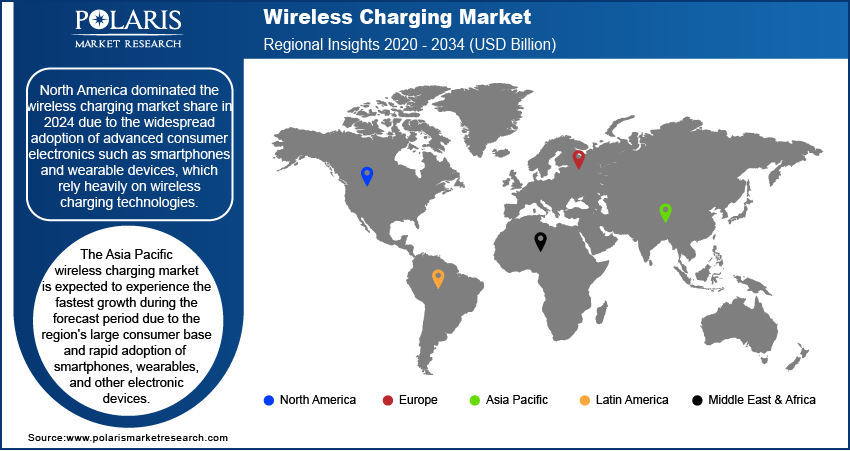
Wireless Charging Market Size, Share, Trends, Industry Analysis Report: By Technology (Inductive, Resonant, Radio Frequency, and Others), Application, Component, and Region (North America, Europe, Asia Pacific, Latin America, and Middle East & Africa) – Market Forecast, 2025–2034
- Published Date:Feb-2025
- Pages: 128
- Format: PDF
- Report ID: PM1415
- Base Year: 2024
- Historical Data: 2020-2023
Wireless Charging Market Overview
The wireless charging market size was valued at USD 8.41 billion in 2024. The market is projected to grow from USD 10.15 billion in 2025 to USD 57.16 billion by 2034, exhibiting a CAGR of 21.2% during the forecast period.
Wireless charging, also referred to as “inductive charging,” is an innovative technology that allows for the convenient charging of devices without a charging cable. The widespread adoption of wireless charging in consumer electronics such as smartphones and tablets drives the wireless charging market growth. This technology offers a convenient, cable-free solution to power devices, with applications expanding into the automotive, healthcare, industrial, and defense sectors. Wireless charging systems have become more efficient, supporting faster charging speeds and improved energy transfer, which enhances user experience as technology advances. Wireless charging is also transforming wearable technology by enabling compact, waterproof, and fully sealed designs. The emerging trend toward smaller gadgets and consumer demand for flexible, faster charging solutions would fuel the market growth in the coming years. Despite its advantages, wireless charging is generally more expensive than wired charging, with compatibility limited to Qi-enabled devices. For instance, in April 2023, the wireless power consortium (WPC) released the Qi2 standard following the approval of the Qi v. 2.0 Interface Specification. The new standard enhances energy efficiency, faster charging, and broader compatibility for mobile devices and wearables, addressing consumer demand for sustainable and reliable products. However, as charging pads become more compact and durable, consumer preference for wireless solutions is expected to rise during the forecast period, reshaping the way devices are powered across various sectors.

To Understand More About this Research: Request a Free Sample Report
Wireless Charging Market Dynamics
Rising Adoption of Smart and Portable Devices
The growing use of smartphones, tablets, wearables, and other portable electronics has boosted the demand for wireless charging solutions. The elimination of tangled wires and the ease of simply placing devices on a charging pad have become key selling points as consumers increasingly seek convenience. The trend toward smaller, more compact devices further amplifies this demand, as wireless charging enables manufacturers to create sleeker, more streamlined products without compromising functionality. In September 2024, Apple introduced the iPhone 16 Pro Max Titanium, featuring a 4,865mAh battery with support for 15W wireless charging. The device takes approximately 2 hours and 20 minutes to achieve a full charge using a compatible 15W wireless charger. This shift toward smart and portable devices is a primary driver for the wireless charging market growth.
Increasing Sales of Electric Vehicles and Demand for Wireless Charging
The rise in electric vehicle (EV) sales is driving demand for more innovative charging solutions, including wireless charging systems. Both consumers and manufacturers are seeking more efficient, user-friendly ways to charge vehicles with the growing adoption of EVs. In November 2024, InductEV highlighted its three-year program with Volvo Cars at the World of Volvo Experience Center in Gothenburg, Sweden. The initiatives are a part of Volvo's Green City Zone project, which showcased 20 electric XC40 taxis using InductEV's wireless, in-ground charging technology, achieving 100% uptime and seamless performance under various conditions, marking a milestone for future autonomous taxi fleets. Wireless charging offers the advantage of eliminating the need for physical connectors and cables, providing a more seamless and convenient charging experience. The wireless charging market demand is poised for continued growth, supporting the broader adoption of electric mobility as EV infrastructure expands and charging systems become more advanced.

Wireless Charging Market Segment Analysis
Wireless Charging Market Assessment by Technology Outlook
The global wireless charging market segmentation, based on technology, includes inductive, resonant, radio frequency, and others. The inductive segment held the largest wireless charging market share in 2024 due to its simplicity, cost-effectiveness, and wide adoption in consumer electronics. Inductive charging works through electromagnetic induction, where an electric current is transmitted between two coils, enabling efficient power transfer. This technology is well-established and has been integrated into devices such as smartphones, wearables, and home appliances. Its widespread use in everyday consumer devices and compatibility with the Qi standard further solidifies its market leadership, making it the most popular choice in wireless charging solutions.
Wireless Charging Market Evaluation by Application Outlook
The global wireless charging market segmentation, based on application, includes automotive, consumer electronics, industrial, healthcare, defense, and others. The consumer electronics segment is expected to witness the highest growth rate during the forecast period due to the high demand for convenient, cable-free charging solutions in smartphones, tablets, wearables, and other portable devices. Wireless charging technology has gained significant traction in this sector as consumers increasingly prioritize convenience and aesthetics. The growth of the IoT ecosystem and the trend toward smaller, more compact devices further drive this demand. Consumer electronics continues to lead the market in terms of volume and innovation with the widespread adoption of wireless charging standards such as Qi.

Wireless Charging Market Regional Insights
By region, the study provides wireless charging market insights into North America, Europe, Asia Pacific, Latin America, and the Middle East & Africa. North America dominated the wireless charging market share in 2024 due to the widespread adoption of advanced consumer electronics, such as smartphones and wearable devices, which rely heavily on wireless charging technologies. The region's strong focus on research and development, backed by investments from technology giants, further fueled innovation in this sector. Additionally, the growing demand for electric vehicles (EVs) in the US and Canada boosted the adoption of wireless charging solutions for EVs, enhancing the regional market growth. The California Energy Commission (CEC) is investing up to USD 100 million annually through its Clean Transportation Program to develop charging infrastructure and support the transition to zero-emission vehicles (ZEVs) in California. This initiative aligns with the state’s climate goals, including achieving 1.5 million ZEVs by 2025 and 100% ZEV sales by 2035. The presence of a well-established technology infrastructure and early adoption of innovative solutions positioned North America as a leader in the wireless charging market. Moreover, supportive government policies and increasing collaborations among key industry players contributed to its market dominance.

The wireless charging market in Asia Pacific is expected to experience the fastest growth due to the region's large consumer base and rapid adoption of smartphones, wearables, and other electronic devices. Countries such as China, Japan, and South Korea are leading innovation, driven by their robust electronics manufacturing industries and investments in wireless charging technologies. The growing electric vehicle (EV) market in the region, supported by government incentives and increasing EV infrastructure development, is also propelling the regional market growth. Additionally, rising disposable incomes and urbanization have boosted consumer demand for advanced technologies. Collaborations between global and local players further contribute to the wireless charging market expansion in the region.
Wireless Charging Market – Key Players and Competitive Analysis
The competitive landscape of the wireless charging market features a mix of global leaders and regional players competing to capture market share through innovation, strategic partnerships, and regional expansion. Key global players such as Qualcomm, Samsung, and Powermat Technologies leverage their strong R&D capabilities and extensive distribution networks to deliver advanced wireless charging solutions. Wireless charging market trends show increasing demand for technologies such as fast-charging solutions, Qi-enabled devices, and wireless charging for electric vehicles (EVs), driven by advancements in consumer electronics and EV infrastructure. The wireless charging market is projected to experience significant growth, particularly in regions such as Asia Pacific, which is expected to record the highest CAGR. Regional players capitalize on localized needs by offering cost-effective and customized solutions, especially in emerging markets. Competitive strategies include mergers and acquisitions, collaborations with technology providers, and the introduction of innovative products to meet growing consumer demand for convenience and sustainability. These developments highlight the importance of technological innovation, market adaptability, and regional investments in driving the expansion of the wireless charging industry. Apple Inc.; ConvenientPower; Energizer Holdings, Inc.; Leggett & Platt, Incorporated; MediaTek Inc.; Mojo Mobility Inc.; Murata Manufacturing Co., Ltd.; PLUGLESS POWER INC.; Powercast Corporation; Powermat; Qualcomm Technologies, Inc.; Renesas Electronics Corporation; Texas Instruments Incorporated; and WiTricity Corporation are a few key major market players.
Apple Inc., an American multinational technology company headquartered in Cupertino, California, has evolved from its origins as a personal computer manufacturer into a leader in consumer electronics, software, and services. The company's flagship products include iPhone, iPad, Mac computers, Apple Watch, and AirPods. One of Apple's significant innovations is its approach to wireless charging. Introduced with the iPhone 8 and iPhone X in 2017, Apple adopted the Qi wireless charging standard, allowing users to charge their devices without plugging in cables. This technology utilizes electromagnetic fields to transfer energy between a charging pad and the device, enhancing user convenience and promoting a cleaner design devoid of ports. Apple's wireless charging ecosystem includes accessories such as the MagSafe Charger for iPhones and the AirPods charging case. In addition to convenience, Apple emphasizes safety and efficiency in its wireless charging solutions. The MagSafe technology aligns magnets within the charger and device for optimal placement, ensuring efficient energy transfer while preventing overheating. This innovation improves charging speeds and it also enhances user experience by simplifying the process of connecting devices to power sources.
Qualcomm Technologies, Inc. is an American multinational corporation headquartered in San Diego, California, specializing in wireless technology. Established in 1985 by Irwin Jacobs and a group of co-founders, Qualcomm has pioneered advancements in digital wireless communications, particularly through its development of CDMA technology which became integral to mobile communication standards such as 3G and 4G. The company operates primarily as a fabless semiconductor manufacturer, focusing on designing and marketing integrated circuits and system software for various wireless applications, including smartphones, laptops, and IoT devices. In addition to its core semiconductor business, Qualcomm has made significant strides in the realm of wireless charging technology. The company acquired HaloIPT in 2011, a firm specializing in wireless electric vehicle charging solutions. This acquisition underscored Qualcomm's commitment to expanding its influence in the automotive sector and enhancing the convenience of charging electric vehicles without physical connections. Qualcomm's wireless charging technologies are designed to enable efficient energy transfer through electromagnetic fields, allowing devices to charge simply by being placed on a compatible surface. This innovation simplifies the user experience and aligns with the growing demand for sustainable and convenient energy solutions in a world increasingly reliant on mobile and connected devices.
List of Key Companies in Wireless Charging Market
- Apple Inc.
- ConvenientPower
- Energizer Holdings, Inc.
- Leggett & Platt, Incorporated
- MediaTek Inc.
- Mojo Mobility Inc.
- Murata Manufacturing Co., Ltd.
- PLUGLESS POWER INC.
- Powercast Corporation.
- Powermat
- Qualcomm Technologies, Inc.
- Renesas Electronics Corporation.
- Texas Instruments Incorporated.
- WiTricity Corporation
Wireless Charging Industry Development
In January 2024, Valeo launched Ineez Air Charging, a wireless EV charging solution operating at a low frequency of around 3kHz. This system offers high efficiency, compatibility with various grids and vehicles, and Vehicle-to-Grid (V2G) functionality. It is designed for public and private charging locations.
In December 2024, InductEV and ENRX collaborated on establishing global standards for wireless inductive EV charging. This partnership aims to enhance compatibility, accelerate adoption, and support the widespread use of high-power wireless charging technology in the transportation sector.
Wireless Charging Market Segmentation
By Component Outlook (Revenue, USD Billion, 2020–2034)
- Transmitters
- Receivers
By Technology Outlook (Revenue, USD Billion, 2020–2034)
- Inductive
- Resonant
- Radio Frequency
- Others
By Application Outlook (Revenue, USD Billion, 2020–2034)
- Automotive
- Consumer Electronics
- Industrial
- Healthcare
- Defense
- Others
By Regional Outlook (Revenue, USD Billion, 2020–2034)
- North America
- US
- Canada
- Europe
- Germany
- France
- UK
- Italy
- Spain
- Netherlands
- Russia
- Rest of Europe
- Asia Pacific
- China
- Japan
- India
- Malaysia
- South Korea
- Indonesia
- Australia
- Vietnam
- Rest of Asia Pacific
- Middle East & Africa
- Saudi Arabia
- UAE
- Israel
- South Africa
- Rest of Middle East & Africa
- Latin America
- Mexico
- Brazil
- Argentina
- Rest of Latin America
Wireless Charging Market Report Scope
|
Report Attributes |
Details |
|
Market Size Value in 2024 |
USD 8.41 billion |
|
Market Size Value in 2025 |
USD 10.15 billion |
|
Revenue Forecast by 2034 |
USD 57.16 billion |
|
CAGR |
21.2% from 2025 to 2034 |
|
Base Year |
2024 |
|
Historical Data |
2020–2023 |
|
Forecast Period |
2025–2034 |
|
Quantitative Units |
Revenue in USD billion and CAGR from 2025 to 2034 |
|
Report Coverage |
Revenue Forecast, Market Competitive Landscape, Growth Factors, and Trends |
|
Segments Covered |
|
|
Regional Scope |
|
|
Competitive Landscape |
|
|
Report Format |
|
|
Customization |
Report customization as per your requirements with respect to countries, regions, and segmentation. |
FAQ's
• The global wireless charging market size was valued at USD 8.41 billion in 2024 and is projected to grow to USD 57.16 billion by 2034
• The global market is projected to register a CAGR of 21.2% during the forecast period
• North America dominated the market share in 2024.
• A few key players in the market are Apple Inc.; ConvenientPower; Energizer Holdings, Inc.; Leggett & Platt, Incorporated; MediaTek Inc.; Mojo Mobility Inc.; Murata Manufacturing Co., Ltd.; PLUGLESS POWER INC.; Powercast Corporation; Powermat; Qualcomm Technologies, Inc.; Renesas Electronics Corporation; Texas Instruments Incorporated; and WiTricity Corporation.
• The inductive segment held the largest market share in 2024.
• The consumer electronics segment is expected to witness the highest growth rate during the forecast period.
